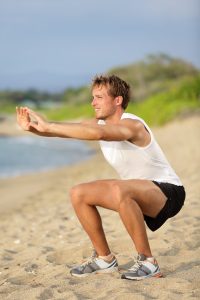We all know we should move our bodies. We know this instinctively – how often have you felt stiff after sitting in a certain position too long, only for that stiffness to disappear within a few moments of moving? Movement is the main form of medicine our bodies require. Here we revealed the difference between activity, exercise and training.
It’s not just our physical health that movement affects – our mental health is improved with regular movement too. We experience a release of endorphins during and post exercise, plus there’s a sense of accomplishment we have following exercise.
Our bodies remind us that movement is good in lots of ways.
We’re also externally encouraged to move. The various health authorities the world over remind us to exercise. In the UK, the NHS suggests we take 30 minutes of moderate exercise, five days per week.
What exactly does that mean? What is exercise? What is activity? What is training? In this article we’ll discuss the differences between ‘Activity’, ‘Exercise’ and ‘Training’ to help you understand the fundamental differences between them all.
Activity
Activity can be defined as general day-to-day movement. The kind of movement we do without considering it exercise.

You might have a physical job – if you’re a gardener, builder, window cleaner, warehouse man etc, there’s a good chance you’ll be on your feet a lot. This is an example of someone with a high level of activity. If you walk your dog, walk your kids to school, walk to the bus/train, do a lot of housework or garden work etc, you’ll be considered generally active.
These all require movement, but they don’t necessarily count as exercise.
You may be aware of the 10,000 steps per day guideline – this is an example of encouraging activity.
So activity is day-to-day movement that we don’t consider exercise.
Exercise
Exercise is when we move with the intention of improving our general health, but without a specific aim in mind.
For a lot of us, our exercise can be multi-use – an example being if you play 5 a side football, the main aim is to play football. The improved fitness is an added bonus. You may cycle to work. The purpose is to get to work – the bonus is the improved fitness.

There are examples of exercise though, such as going for a run. You may not be timing yourself or aiming to get faster, you’re just running for the sake of being fit.
An exercise DVD in the comfort of your home is similar – you are moving your body with the intention of improving your health, but you’re not aiming to improve a specific outcome measure by a given amount, such as reduce your 5km run time by 20 seconds, for example.
In making these choices, we’ve made a choice that we know will improve our health, but we aren’t monitoring progress. We aren’t after a specific outcome necessarily, it’s quite general.
Training
Training is exercise with the aim of making an measured improvement in a particular skill or physical ability. It’s typically where you’ll follow a specifically-designed training programme designed to bring about the particular change.

If you go into the gym with a particular goal in mind, such as “I want to deadlift twice my body weight”, then you’ll have to train towards the goal – exercise won’t get you there, you’ll have to train. You’ll have to perform progressively heavier lifts and accessory exercises based around your goal. You’ll make adjustments to the plan relative to regular testing of your abilities relative to the goal.
Training is something that is structured, measured and is totally outcome-based, whereas something like 5 a side football would vary in intensity each week.
To get the most from the gym, you’ll want to train, rather than exercise. If you exercise in the gym, you’re likely to see little in the way of real physical change.
Activity, Exercise and Training: Conclusion
All movement for your body is good, so it’s not that any one of these is better than the others – they all serve their purpose in the overall scheme of things.
If you want to be generally fit and healthy, you only need to focus on achieving a consistent amount of activity and exercise. That should be enough to see you lead a fit and healthy life.
If however, your physical goals are a little more extreme, you’ll have to follow a structured training plan and work hard towards its completion. Anyone serious about significant physical change has to either work very hard or be incredibly gifted genetically. Most of us need the hard work!
